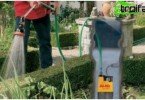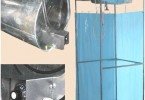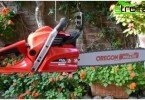Submersible Water Pumps
Often the water supply of garden and summer cottages leaves much to be desired. Mostly water is extracted from wells and wells. Many site owners, taking care of convenience, try to automate this process using submersible water pumps. Some pumps are installed on top (surface), while others are immersed completely under water (submersible). Submersible water pumps are most often used for:
- water supply to the water supply system;
- pumping water;
- organization of irrigation systems;
- to create artificial streams, waterfalls and fountains;
- for drainage work.
Content
- Submersible pump device
- How to choose the best option?
- Connection and installation of a submersible pump
The types of submersible pumps include drainage and fecal pumps, as well as a garden submersible pump, which is used for irrigation and irrigation. To drain dirty water with a lot of debris from pools and sewage pits, a submersible drainage pump is used. Fecal pumps are usually used for cleaning cesspools, thoroughly cleaning wells from clay and sand, etc. These pumps can pump liquid containing impurity particles up to 5 cm in size. In the summer cottage, especially in the spring, there may be a need to quickly pump water from the reservoir, drain the basement, and pump water from the basement, most often not very clean.
A good assistant in this situation will be a submersible pump for dirty water. Submersible water pump according to the principle of action can be centrifugal or vibration. A vibrating submersible pump is selected if an assembly that can be lowered into a well is required to be inexpensive, with small capacity, but with a large suction depth. More perfect from a practical and technical point of view is a centrifugal water pump. It does not create rattles and noise, like vibration, this allows you to use it not only in wells, but also in wells. The performance of a centrifugal domestic pump is significantly higher. Centrifugal in turn are divided into screw and vortex pumps..
- The screw pump has a simple design and is intended for pumping pure water or a liquid that contains impurities (no more than 300 g / m?). It is distinguished, most often, by low price and reliability..
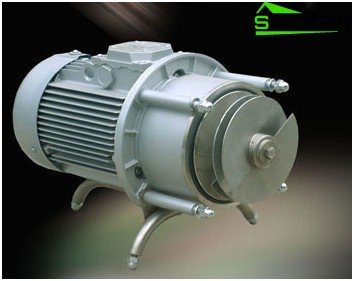
A typical screw pump is used to supply water to the system without contaminants.
- Centrifugal-vortex submersible pump at high power is characterized by high pressure. Its disadvantage is excessive sensitivity to impurities in the liquid. Under the influence of solid particles, the case and wheels (blades) undergo intensive wear, the gap between them becomes larger and the efficiency decreases noticeably.
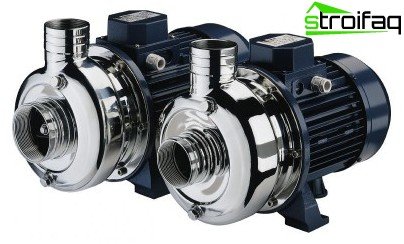
Centrifugal Submersible Pump Models
Submersible pump device
The design of the submersible pump depends on its model. The centrifugal pump has an impeller with blades enclosed in a housing and connected to the motor shaft. Water, when the impeller rotates, fills the pump and, under the action of centrifugal force, is pushed out of the casing, which is made in the form of a snail shell, into the pipeline and through it is fed into the tank or immediately to the points of water intake. When the impeller rotates, a vacuum is created in the nozzle, which serves for suction, so water enters the pipeline continuously.
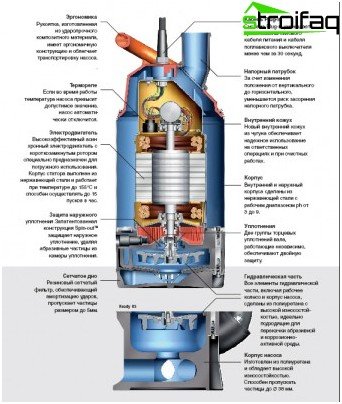
Internal arrangement of submersible pump
In drainage pumps, the working chamber is quite wide, this allows impurities to pass freely through it, without delay and without damaging the mechanism. Since the suction hole is located in the lower part of the unit, it is able to pump out almost all the liquid, it is enough to lower it to the bottom of the tank. Additional convenience is provided by built-in automatic devices that turn off the motor during dry operation or overheating. The float switch, which is equipped with submersible pumps of this kind, allows the unit to independently start up when necessary. The dirty water pump most often has an impeller made of cast iron or stainless steel.
How to choose the best option?
The choice of pump should be based on knowledge of the planned level of water consumption and, accordingly, the required pressure. There is a fairly simple formula that will answer the question of how to choose a submersible pump of the required power: Ntreb = Ndin + Nnap In which Ntreb is the required water pressure; Ndin is the dynamic water level (this is the distance to the water level from the ground when the pump is on; Nnap is the distance to the consumption point from the well. Thus, when choosing submersible pumps for cottages, it is necessary, first of all, to determine the operating parameters: flow rate (Q ) and head (H). Water consumption is easily determined if we summarize the performance of all water intake points and take into account the possibility of their simultaneous use. Simplified calculations can be made using the following standards:
- washbasin – 60 l / h;
- kitchen sink – 500 l / h;
- bathroom – 300 l / h;
- shower – 500 l / h;
- flushing tank – 83 l / h;
- watering crane – 1080 l / h (consumption depends on the method and intensity of irrigation);
- bath, sauna – approximately 1000 l / h.
It should also be taken into account that in summer there is often a need for watering the garden, and this affects the level of water consumption. In addition, the number of consumers and points of water intake is important. When choosing a pump for dirty water, it is important to decide where and for what purpose it will be used. The degree of contamination of the supplied water is an important criterion. The passport of each product says what particle size it can pump along with water without damage to the mechanism. Many people think that 10 mm is enough for giving.
Since drainage pumps are not used to supply water upward, their pressure is most often small, within 10 m, but with a horizontal supply, this figure can be multiplied by 10. Modern models of drainage pumps practically do not require complicated maintenance. The owner himself can quite cope with the change and cleaning the filter.
Connection and installation of a submersible pump
Unfortunately, it was noticed that submersible pumps quite often fail. The reason, however, is far from always in the low quality of the equipment, but more often in the fact that the selection of equipment is not always done by professionals to develop a project and install a submersible pump. Sometimes the connection diagram of a submersible pump is drawn up by the owners of private houses themselves, who have a very vague idea of how it should look. Few people know that a pump engine that is selected with a large margin of power can burn out very quickly if, during installation and configuration of the entire system, the pump is not brought to the optimum operating range. Therefore, it is cheaper and more rational to choose a pump, taking into account real needs and with the direct assistance of specialists.
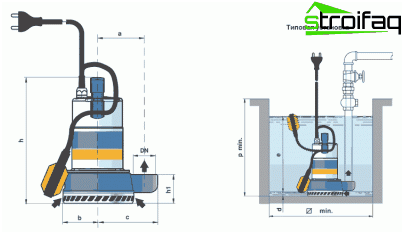
Typical installation diagram for any submersible pump
How to install a submersible pump? When installing any pump, it is necessary to verify its operating point in all operating modes that are possible. When putting it into operation measure:
- the supplied flow rate, for this the speed with which any capacity of a known volume is filled is determined;
- created pressure (it is determined by the pressure gauge);
- current consumption, measured with special forceps.
The data obtained are carefully verified with the passport characteristics. If the operating parameters are significantly exceeded, it is necessary to take measures: close the valve, create resistance, so that the correct operating point is established – the middle of the Q (N) characteristic. All these manipulations should not be done on their own. Installation, like the choice of the pump, should be carried out by a trained specialist, only then can we count on its long-term and efficient operation.


